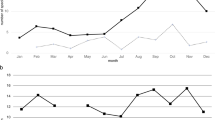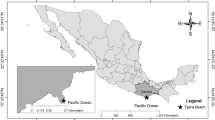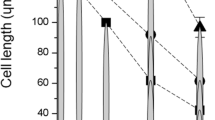Abstract
Cloning among metazoan larvae is rare and generally restricted to a few phyla with parasitic or colonial life-histories. Echinoderms are all non-colonial animals, and although cloning is well docu-mented for some adults, its occurrence in larval stages has not been previously observed1–3. Here we describe a novel mode of cloning by fission in planktotrophic bipinnaria larvae of the sea star Luidia sp. from the Sargasso Sea and the Gulf Stream. Reproductive larvae were widely distributed, comprising about 30% of sample populations. This represents an extensive multi-plicative potential whereby the pelagic life of the genet is prolonged and the potential of recruitment into benthic adult populations can be enhanced.
This is a preview of subscription content, access via your institution
Access options
Subscribe to this journal
Receive 51 print issues and online access
$199.00 per year
only $3.90 per issue
Buy this article
- Purchase on Springer Link
- Instant access to full article PDF
Prices may be subject to local taxes which are calculated during checkout
Similar content being viewed by others
References
Emson, R. H. & Wilkie, I. C. Oceanogr. mar. Biol. A. Rev. 18, 155–250 (1980).
Hughes, R. N. & Cancino, J. M. in Population Biology and Evolution of Clonal Organisms (eds Jackson, J. B. C., Buss, L. W. & Cook, R. E.) 153–186 (Yale University Press, New York, 1985).
Lawrence, J. M. A Functional Biology of Echinoderms (Johns Hopkins University Press, Maryland, 1987).
Komatsu, M. et al. in Echinoderms: Proceedings of the International Conference, Tampa Bay (ed. Lawrence, J. M.) 497–503 (Balkema, Rotterdam, 1982).
Strathmann, R. R. J. exp. mar. Biol. Ecol. 6, 109–160 (1971).
Wilson, D. P. J. mar. biol. Ass. U.K. 58, 467–478 (1978).
Dehn, P. F. in Echinoderms: Present and Past (ed. Jangoux, M.) 361–367 (Balkema, Rotterdam, 1980).
Domanski, P. A. Mar. Biol. 80, 189–195 (1984).
Hyman, L. H. The Invertebrates: Echinodermata (McGraw-Hill, New York, 1955).
Henley, C. in Reproduction of Marine Invertebrates Vol. 1 (eds Giese, A. C. & Pearse, J. S.) 1–213 (Academic, New York, 1975).
Schroeder, P. C. & Hermans, C. O. in Reproduction of Marine Invertebrates Vol. 3 (eds Giese, A. C. & Pearse, J. S.) 267–343 (Academic, New York, 1975).
Lasserre, P. in Reproduction of Marine Invertebrates Vol. 3 (eds Giese, A. C. & Pearse, J. S.) 215–275 (Academic, New York, 1975).
Mortensen, T. Studies of the Development and Larval Forms of Echinoderms (Gad, Copenhagen, 1921).
Thorson, G. in Oceanography (ed. Sears, M.) 455–474 (Am. Assn Adv. Sci. Washington, DC, 1961).
Delap, M. & Delap, C. Rep. Sea inld Fish. Ire. Vol. 2, 141–159 (1907).
Pickard, G. L. & Emery, W. J. Physical Oceanography: An Introduction (Pergamon, New York, 1982).
Clark, A. M. Bull. Br. Mus. nat. Hist. (Zool.) 42, 157–184 (1982).
Gage, J. D. & Tyler, P. A. Mar. Biol. 64, 153–161 (1981).
Author information
Authors and Affiliations
Rights and permissions
About this article
Cite this article
Bosch, I., Rivkin, R. & Alexander, S. Asexual reproduction by oceanic planktotrophic echinoderm larvae. Nature 337, 169–170 (1989). https://doi.org/10.1038/337169a0
Received:
Accepted:
Issue Date:
DOI: https://doi.org/10.1038/337169a0
This article is cited by
-
Limited genetic signal from potential cloning and selfing within wild populations of coral-eating crown-of-thorns seastars (Acanthaster cf. solaris)
Coral Reefs (2021)
-
Forever fissiparous: asexual propagation and stable demography in a tropical and geographically isolated asterinid sea star
Marine Biology (2019)
-
Bacterial communities of oceanic sea star (Asteroidea: Echinodermata) larvae
Marine Biology (2016)
-
Why run and hide when you can divide? Evidence for larval cloning and reduced larval size as an adaptive inducible defense
Marine Biology (2010)
-
Widespread cloning in echinoderm larvae
Nature (2003)
Comments
By submitting a comment you agree to abide by our Terms and Community Guidelines. If you find something abusive or that does not comply with our terms or guidelines please flag it as inappropriate.



